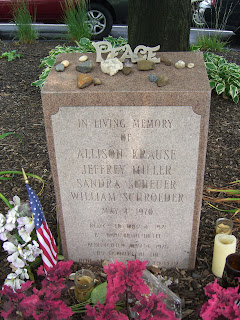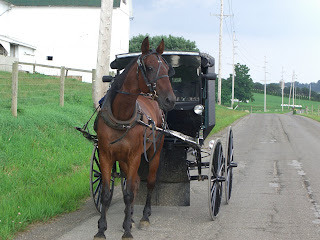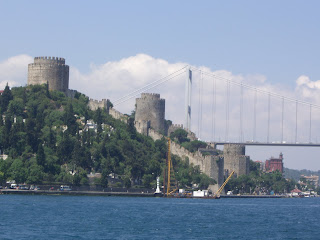 I'm back home in California enjoying my family and garden once again! I managed to bring back a bottle of Cappadocian wine for George, but not without being stopped multiple times by airport security. I left Ohio in a thunderstorm, as you can see in this first photo. But at 35,000 feet above Indiana the sky became splendid.
I'm back home in California enjoying my family and garden once again! I managed to bring back a bottle of Cappadocian wine for George, but not without being stopped multiple times by airport security. I left Ohio in a thunderstorm, as you can see in this first photo. But at 35,000 feet above Indiana the sky became splendid.  And as I approached the West Coast the scenery became even more interesting; you could see all those mountain ridges; they looked like one of those fake plastic three-dimensional maps.
And as I approached the West Coast the scenery became even more interesting; you could see all those mountain ridges; they looked like one of those fake plastic three-dimensional maps.  Then the massive mountains became even clearer; I kept thinking about Lewis and Clark as they explored.
Then the massive mountains became even clearer; I kept thinking about Lewis and Clark as they explored.  By the time we approached Salt Lake City, Utah, the sun began to set, and after a long lay-over it was too dark to take pictures out the plane window.
By the time we approached Salt Lake City, Utah, the sun began to set, and after a long lay-over it was too dark to take pictures out the plane window.  I'm happy to be home, especially because while in Ohio I realized that I felt a bit melancholic, which is expected after such an intense time abroad. But then as Yuko and I drove around, it occurred to me that it was the same sort of melancholy I felt among the ruins in Turkey, the same kind that Orhan Pamuk describes in his memoir, Istanbul: Memories and the City. In Turkey, Pamuk writes, it's easy to feel hürzün, because the physical remains of decay and destruction are clearly visible everywhere; broken remnants of grandeur loom.
I'm happy to be home, especially because while in Ohio I realized that I felt a bit melancholic, which is expected after such an intense time abroad. But then as Yuko and I drove around, it occurred to me that it was the same sort of melancholy I felt among the ruins in Turkey, the same kind that Orhan Pamuk describes in his memoir, Istanbul: Memories and the City. In Turkey, Pamuk writes, it's easy to feel hürzün, because the physical remains of decay and destruction are clearly visible everywhere; broken remnants of grandeur loom.  In central Ohio there's the same kind of permeating low-grade sadness, because, I think, you're surrounded by so many old houses, the majority disheveled, and beautiful yet abandoned brick buildings that had once been used for all sorts of industry--so much seems to be in need of repair; so much seems to be at its sunset. And in the summer heat and humidity, as in the bitter cold and snow of winder, the streets are deserted; everyone seems esconced in their airconditioned corners of the world. Of course, like in Turkey, if you look closely, if you delve beneath the surface, you'll see much newness, excitement and pulsating change everywhere too (just look at some of my favorite pictures), but because of the overwhelming decay it's easy to feel melancholy, hürzün.
In central Ohio there's the same kind of permeating low-grade sadness, because, I think, you're surrounded by so many old houses, the majority disheveled, and beautiful yet abandoned brick buildings that had once been used for all sorts of industry--so much seems to be in need of repair; so much seems to be at its sunset. And in the summer heat and humidity, as in the bitter cold and snow of winder, the streets are deserted; everyone seems esconced in their airconditioned corners of the world. Of course, like in Turkey, if you look closely, if you delve beneath the surface, you'll see much newness, excitement and pulsating change everywhere too (just look at some of my favorite pictures), but because of the overwhelming decay it's easy to feel melancholy, hürzün.  Orhan Pamuk explains that there are two different Muslim traditions that help to define and clarify hürzün: one derives from the Koran and likens hürzün to deep spiritual loss (such as the one the Prophet Muhammad experienced the year he lost both his wife Hatice and his uncle Ebu Talip), and to agony and grief at having invested too much in the transitory material things that can and will be lost.
Orhan Pamuk explains that there are two different Muslim traditions that help to define and clarify hürzün: one derives from the Koran and likens hürzün to deep spiritual loss (such as the one the Prophet Muhammad experienced the year he lost both his wife Hatice and his uncle Ebu Talip), and to agony and grief at having invested too much in the transitory material things that can and will be lost. 
The other tradition is rooted in Sufi mysticism: it likens hürzün with the gnawing awareness of our inadequacies, of how, for example, we can never fully understand or be close enough to God. Symbiotically, though, if we don’t experience hürzün we feel empty and derisory. Pamuk writes that in Sufism it is “the failure to experience hürzün” that leads you to feel it; you suffer because you haven’t suffered enough. He writes that it is by following this logic that Islamic culture has come to hold hürzün in “high esteen.”
 Hürzün is produced by living in and with decomposing fragments—by living in and with the ruins that constantly and concretely remind you that once there was a great Ottoman Empire, and that perhaps such grandeur can never again be reconstructed. Hürzün in Turkey, Pamuk says, has evolved into a cultural concept that equates to an attuned awareness of worldly failure, listlessness and spiritual suffering and that it is often associated not just with the loss or death of a loved one, but also with other spiritual afflictions like anger, love, rancor, defeat and groundless fear. So... the symbiosis in that concept is surely worth further consideration, don't you think?
Hürzün is produced by living in and with decomposing fragments—by living in and with the ruins that constantly and concretely remind you that once there was a great Ottoman Empire, and that perhaps such grandeur can never again be reconstructed. Hürzün in Turkey, Pamuk says, has evolved into a cultural concept that equates to an attuned awareness of worldly failure, listlessness and spiritual suffering and that it is often associated not just with the loss or death of a loved one, but also with other spiritual afflictions like anger, love, rancor, defeat and groundless fear. So... the symbiosis in that concept is surely worth further consideration, don't you think? *******
*******In the Muslim writing tradition travelers keep a Rihla, a journal that documents a trip taken precisely to learn (as in the Hajj, or pilgrimage to Mecca)--to learn about yourself, about a country, another culture, its people, habits, quirks, sorrows and delights; in other words, to learn by entering and immersing yourself in that new setting, which, of course, if done right, requires that you dispel preconceived notions. That kind of stripping of yourself is very difficult, but surely beneficial. I started to learn to step out of my own tiny box a very long time ago, when my family emigrated (and when, perhaps consequently, I began to yearn to travel) and then when I started to read travel narratives like those by Ibn Battuta. Ibn Battuta started traveling in the year 1325 when he was 20. His aim was to partake of the Hajj, as all Muslims do, if they can. And the purpose of the Hajj is not just to pay homage; it is also to seek knowledge, to learn and then DO something worthy with that newly gathered information. But the Hajj to Mecca wasn't enough for Ibn Battuta; he continued to wander for about 29 years through 75,000 miles and visited what was then the Muslim World, Dar al-Islam, through (what today would be considered) 44 modern countries (e.g., Turkey, Morocco, India, China). And through it all he kept a Rihla, which today allows us to understand him, and the people and places he met and visited. Without his Rihla, we'd have a more limited view of him and that world such a long time ago. (There are many books about Ibn Battuta; a good starting one is The Adventures of Ibn Battuta, a Muslim Traveler of the 14th Century by Ross E. Dunn.)
 Today the connotation of the word "rihla" is different than it was when Ibn Battuta traveled. Back then, the word was more directly linked to the Prophet Muhammad's traditional injunction to "seek knowledge," which legitimated the need to travel beyond doing the Hajj, and probably fed wanderlust. That injunction gave rise, in the Islamic middle ages, to the concept of al-rihla fi talab al-'ilm, travel in search of knowledge. Then, in Islamic North Africa in the 12th to 14th centuries, as paper became increasingly available, educated men began to write and distribute their first-hand descriptions of their pilgrimages to holy cities and beyond. Such an account was called a rihla, or "travelogue" (which was both a memoir and most definitely a work of spiritual devotion), and it combined the writer's observations and responses to the Hajj with geographical and cultural information about the places and people he met along the way. (And I say "he" because in the Middle Ages very few women traveled and wrote about their experiences.) Today, Rihla is most often directly equated with "travel journal."
Today the connotation of the word "rihla" is different than it was when Ibn Battuta traveled. Back then, the word was more directly linked to the Prophet Muhammad's traditional injunction to "seek knowledge," which legitimated the need to travel beyond doing the Hajj, and probably fed wanderlust. That injunction gave rise, in the Islamic middle ages, to the concept of al-rihla fi talab al-'ilm, travel in search of knowledge. Then, in Islamic North Africa in the 12th to 14th centuries, as paper became increasingly available, educated men began to write and distribute their first-hand descriptions of their pilgrimages to holy cities and beyond. Such an account was called a rihla, or "travelogue" (which was both a memoir and most definitely a work of spiritual devotion), and it combined the writer's observations and responses to the Hajj with geographical and cultural information about the places and people he met along the way. (And I say "he" because in the Middle Ages very few women traveled and wrote about their experiences.) Today, Rihla is most often directly equated with "travel journal." ******
******I won't catalogue what I've learned, since that'd take pages and pages, besides, I need time to truly reflect and understand before I can describe those lessons. But, I can say for sure that I am changed, changed because I have learned about myself and about others. And that change is good, good because it produces valuable insights about how to continue to navigate my life in productive and engaging ways.
 I've enjoyed keeping this blog. It provides a fun record of the highlights of my adventures during summer 2007. That's important to me; I'm an archivist (since, I believe, that too is the essence of history and of what, consequently, constitutes individual and collective identity). I'm used to writing compulsively in my journal, but this blog has required different skills from me. It's caused me to exercise different writing muscles. Simply, writing specifically for you (and for those readers I don't know personally who might happen upon this blog) has required that I think directly about my audience. That is more about omission than it is about inclusion, more about what I leave out than what I choose to reveal to you.
I've enjoyed keeping this blog. It provides a fun record of the highlights of my adventures during summer 2007. That's important to me; I'm an archivist (since, I believe, that too is the essence of history and of what, consequently, constitutes individual and collective identity). I'm used to writing compulsively in my journal, but this blog has required different skills from me. It's caused me to exercise different writing muscles. Simply, writing specifically for you (and for those readers I don't know personally who might happen upon this blog) has required that I think directly about my audience. That is more about omission than it is about inclusion, more about what I leave out than what I choose to reveal to you. Thank you for reading my blog, for being curious and interested in my adventure. I hope that you walk away with some thing, some idea, some feeling--however tiny--that will grow in you and maybe even provide you joy, gratification and impetus to live a fuller life.




















































